Engineered Systems LtdProgramme and Project Management by Ed Johnston |
Mobile +44 (0)7860 663886 |
EGC 2011 Pociunai
A Successful Start
31 Aug: Grid squat and scrubGrey start with very moist air. Despite the obvious problems we all dutifully gridded, filled, weighted and rigged. No task at 10am briefing and as expected, a re-brief at 12 was announced. Also announced, reverting to line finish from ring. A full circle brought us back to a line... Probably the most sensible result as all the notes and organisers experience is for the lines not rings.
One good thing- Nick Tillet is our first winner- the fastest man out of the cockpit as timed by all pilots. Rumour has it that he did so in 4.3s by climbing through the DV panel rather than waste time opening the canopy.  |
Competition Day 1The morning starts off as soggy and overcast, the dampness from yesterday's torrential outpouring still lingering on the ground. People mill about as they rig the gliders, with little confidence that it is not just about to rain.At briefing the met-forecast is summarised as getting good to the North, which might make it down to us later. Or it might just get stormy. Wait and see. Predictably, a re-briefing is set to 1200, and there is a great sense that we are just going through the motions, but we still grid up at the far end of the airfield. We are waiting for the scrub announcement at the re-brief, but surprisingly a 2.5 hour assigned area task is set, with no launch before 1300. At least we can get some practice grid squatting. The no launch time is pushed back to 1400, and the temperature is increasing but cloud base is still low and the air is muggy and humid. Launch time is pushed back further. Finally, the give up call is radioed out, around 1415. This announcement is met with a great many dump valves opening in unison. The flying race is cancelled, but the is still one race remaining: towing the gliders back and getting to the bar.  By
late afternoon the thermals have kicked off and towering cumulonimbus
clouds have formed. The forecast for Monday is a bit better,
with a possible clearing to race in the afternoon when some
better air comes. Tuesday is expected to be “properly good”. By
late afternoon the thermals have kicked off and towering cumulonimbus
clouds have formed. The forecast for Monday is a bit better,
with a possible clearing to race in the afternoon when some
better air comes. Tuesday is expected to be “properly good”.In the evening, after the regular downpour, the temperature dropped a bit and the humidity became much less. While Team GB was enjoying the pleasant weather with another BBQ, a clutch of balloonists turned up. Firing up the big burners, they quickly inflated the balloon and went floating off into the sunset. At least someone did some flying today. The Championships have started with an anti-climax. |
1st Aug: A good startAt last we go. Area tasks for all as there is a thundery air mass to the south and cold front to the north, so no-one really knows what is going to happen. A long time on the grid as clouds build to showers in all directions. When we start launching we find out why- the cloud base is barely above launch height. Just to add to the drama, Gary’s tug has engine failure, fortunately at 1000 with time enough to climb away rather than 20ft over the trees, the normal tow out height. We get going pretty early, but make a bit of a meal of the first leg. We dithered then chose the wrong option, but eventually hooked up with a great streeting run to the end of the first area. Things then became a little testing, with an enormous hole ahead of us. We started by trying to go left, but that was never going to work. Eventually when clouds on track just didn’t work at all, we had to survive by going 90 right off track, gently easing our way towards the forests to the East. Slowly creeping forward, we slightly lost contact eventually turning at different positions, me going further North, closely followed by Gary while Russell who got stuck in the blue turned further in the south. Then we had a decent run back, working our way round a big
shower to reveal another
Else where the team didn’t fare so well. Both the 15m boys landed out and Pete started his engine. Kim was best placed Open class pilot. A really easy day to drop out and we are all looking forward to better conditions promised for the next few days. |
Competition Day 2Yesterday's pleasant evening continued to become a nice morning which gave all the impression that it might become flyable. A nice change indeed.At briefing assigned area tasks AATs were set, with the 18m class getting a two and a half hour task. Launch is set for 1200, but it is delayed until 1230 and then delayed again. Because of the high humidity, cloud base doesn't increase as much as hoped, and, while things are decent above the field, there is a threat of thunderstorms in the surrounding regions. The decision is finally made to start launching at 1300, any later and they would have run the risk of running out of day to finish the task. The grids were set up with the 15m and 18m classes at the front on the left and right respectively, with the open-class behind them both. During launching, the tug pulling Garry Stingemore had an engine failure. Garry has able to soar away but the tug ended up in a field. Another tug on the 18m side also stopped flying, for unknown reasons. This, combined with the fact that the 15m gliders are lighter and numerically fewer, meant that the 15m grid was finished before the 18m. I expected the spare tugs to help finish off the 18m gliders but instead they started launching the open class around the side of the 18m grid. This seemed a rather precarious arrangement, especially with ponderous franken-gliders like the “NimbETA” which have a long ground run. After all the gliders had launched and set off on task, the Team Manager, Shaun, uttered the fateful words “now we can relax and put our feet up”. Even as the words were fresh off his lips, the phone started ringing: both 15m pilots had landed out. Apparently the fields were difficult and the retrieves would be a carry-out jobs. 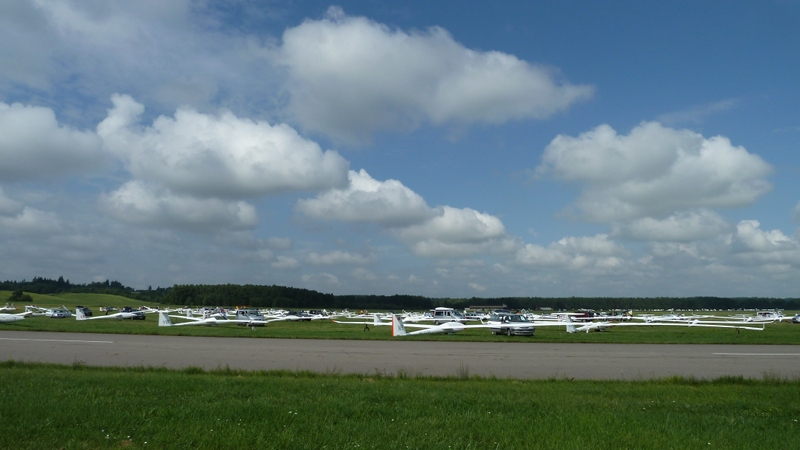 During the day a fold-out lorry containing tracking systems
for the gliders turned up. It has a big pop-up screen on the
top, slightly larger than a laptop screen. The results of the
tracking system itself can also been seen online, but the updates
are sporadic; it's all rather underwhelming.
During the day a fold-out lorry containing tracking systems
for the gliders turned up. It has a big pop-up screen on the
top, slightly larger than a laptop screen. The results of the
tracking system itself can also been seen online, but the updates
are sporadic; it's all rather underwhelming.Although the day was bad for our 15m pilots, the open class did somewhat better, although Pete Harvey had to use his engine, so had a virtual land-out. The three 18m class pilots did very well all coming in the top ten, with Ed getting a forth place. |
2nd August: Better and betterDawned to a bright clear sky with a much fresher feel to it. It really felt like a good soaring day in the making. We all got tasks round the Kaunas TMA for 400k or so, with cloud bases of 3000 rising to 4000, 3-4 kt thermals. Our peak at the weather suggested it might be better. Good soaring conditions were available from the off. We set off mid pack and had a pretty good run down the first leg. The second started well enough, but much less regular climbs meant some slow patches. The three of us also split up a little but stayed more or less in the same air so were able to help each other. The North East turn was tough, worse climbs and more difficult to stay with, being more broken up rather like the first practice day. This eventually gave way to vastly improved conditions on the first half of our West bound track, with 5-7 Kt climbs and long fast running between. However this was under a sky with some significant spread out and you never really knew whether the next climb was actually going to work. The critical phase was round the North East turn where the spread out won and we all ended up groveling. I had a battery go flat at the same time leading to a bit of confusion at the same time as I needed to focus fully. I ended up making a mess of the turn and falling back and being without transmit on the radio. However, having gratefully accepted 1kt climbs at the turn, the sky soon was giving up 5 and 7kt climbs again for a really fast run home. In the end, mildly disappointing having lost so much time at that turn, but damage limited I hope... But maybe some bad news- Nick may not have started by putting the wrong start point in his machine. Indeed, not only was Nick scored for almost zero distance, but his actual flight (minus a critical 3km at the beginning) was within a minute or two of the winners. A really cracking performance and a terrible disappointment for him. |
Competition Day 3The improvement in the weather from yesterday continued last night and a new cold air mass has moved in now the fronts have moved away. The air is very clear so I got up during the night to see the stars. Conditions were ideal. Not only are there are not many street-lights in Lithuania, the airfield is in the middle of nowhere, so there was very little light pollution beyond the campsite illumination. There was also a new moon that night, so the milky way was visible, and I saw several shooting stars.In the morning the grid was opened early in expectation of the good weather. The set tasks were around 400km circles, going round the Kaunas Airport restricted airspace. Launching started at 1200 and everyone was soon on task. For crew this is the ideal situation: with the pilots off on a good long race we can now put our feet up and enjoy tea and cake. Results of the day were mixed in the open class. Pete Harvey had a great day and came in second. The 18m pilots did middling-well. Ed had a power failure halfway through his flight, which threw him off his game. For the 15m Nick Tillett had a fantastic day. Tragically, because of a mistake with the flight computer it is all lost. The trick to winning gliding competitions, so I am told, is not to win every day but to fly consistently and let other people make mistakes. I'm sure winning every day can't be a hindrance. Could this have been the best day of the competition? Definitely not. The best day will be on the 9th when the International Evening is held. Figure 1: The defending European open-class champion giving the signal to start launching. "Left" and "right" really are written on the canopy. Figure 2: A seven glider gaggle under a cloud. |
3rd August: A great runAnother very promising Chrystal clear morning with a good fresh feel to it. Going through the daily routine of rigging and watering we then got tasks of 4-500km into Poland for the Open and 18m tasks, and up the West side of the country for the 15s. We had a decent start, but didn’t nail the first leg. Gary dropped off being a bit more aggressive at the wrong time. We nearly got him back with us on two occasions but he then made a mistake coming North form Poland and struggled back on his own- not a disaster but a bit off the pace.
Meanwhile the 15m boys had a mixed bag. Chris flew a great flight and was second, doing it all on his own as only he can! Nick, after yesterday’s disappointments didn’t have such a good day.
The Latvian evening saw an interesting array of snacks from tasty fish, very fatty pork, deep fried garlic bread and pigs ears (yes really; rather chewy but quite tasty). Free beer of course and a minor blocking from our director for eating pizza to supplement the food. |
Competition Day 4An important task for the crew at gliding competitions is to pass the start time declared by the pilots onto competition control. Pilots must radio in the time at which they cross the start line, and this must be passed onto control within half an hour of the start. Control then use these times to calculate provisional scores. However, in these days of GPS loggers calculating start times is quickly performed by computers, making this whole process rather pointless beyond giving the team captains something to do.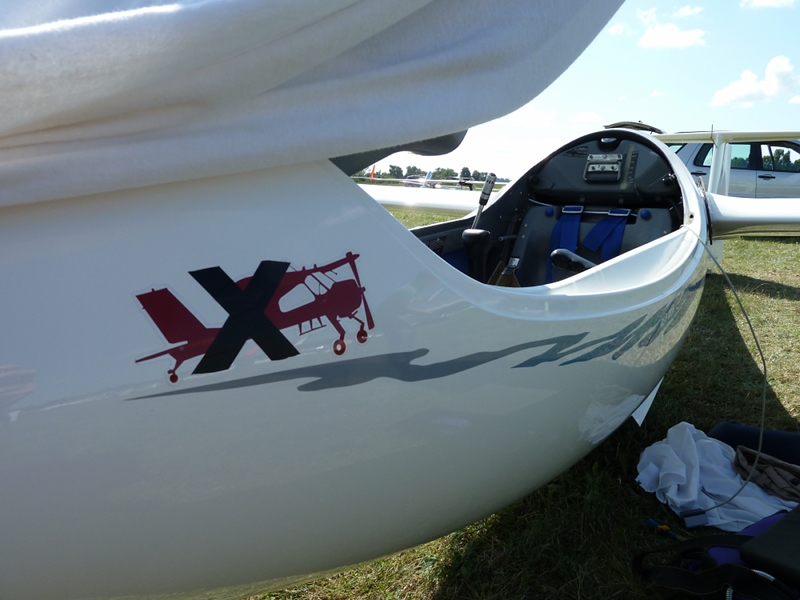 There
is a lot of tactics involved when choosing when to start a task.
Consideration must be taken about how he weather will be changing
along the task area. Start to early and the best part of the
day might be missed. Start to late and there is the risk that
the good lift will end before you can get round. The choices
of the other pilots is also important. There is an advantage
to starting behind other groups and letting them find the good
lift for you. If you are a top place pilot then you might want
to try and sneak away without everyone else using your start
as a queue to also get going. As a result, you will delay announcing
your start time until later in the 30 minute interval. There
is a lot of tactics involved when choosing when to start a task.
Consideration must be taken about how he weather will be changing
along the task area. Start to early and the best part of the
day might be missed. Start to late and there is the risk that
the good lift will end before you can get round. The choices
of the other pilots is also important. There is an advantage
to starting behind other groups and letting them find the good
lift for you. If you are a top place pilot then you might want
to try and sneak away without everyone else using your start
as a queue to also get going. As a result, you will delay announcing
your start time until later in the 30 minute interval.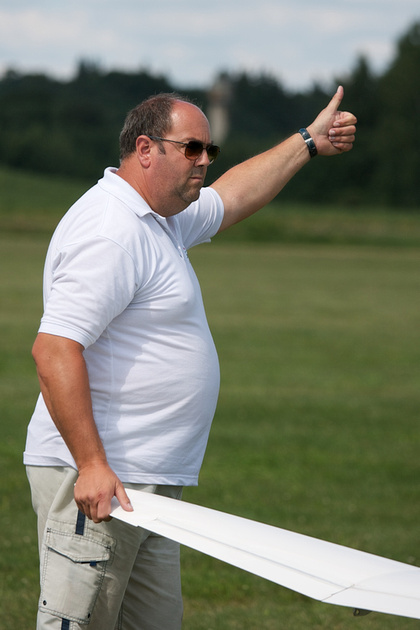 The
British team pilots are convinced that the other teams listen
in on our radio frequency to find out our start times so they
can copy us. In order to confound them they have devised various
codes, and will give the start time in reference to a pre-decided
reference known as “T-time”. Really it is just to make the pilots
feel it is more exciting. Once all the start times are submitted
and the crew can relax the real tea-time occurs – with cake. The
British team pilots are convinced that the other teams listen
in on our radio frequency to find out our start times so they
can copy us. In order to confound them they have devised various
codes, and will give the start time in reference to a pre-decided
reference known as “T-time”. Really it is just to make the pilots
feel it is more exciting. Once all the start times are submitted
and the crew can relax the real tea-time occurs – with cake.Today the weather was again good, and the ante was upped with even longer tasks, ranging from 450km for the 15m gliders to 500km for the open class. Generally the team had a really good day. Chris took second place in the 15m class, being less than 1 km/h slower than the lead. In the 18m class Russell and Ed were forth and sixth place respectively. However, the biggest success was in the open class, where Kim Tipple won the day. In the evening the competition organizers held a Lithuanian evening. I was expecting more Lithuanian country dancing, cold pink soup and large quantities of beer. I was right on only one count. Most of the music was provided by a jazz duo, although the two girls who serve at the bar also gave a gig. One was playing the fiddle and the other the guitar; they were very good. The food was a range of Lithuanian drinking snacks, which were all very tasting, even the pig's ear. |
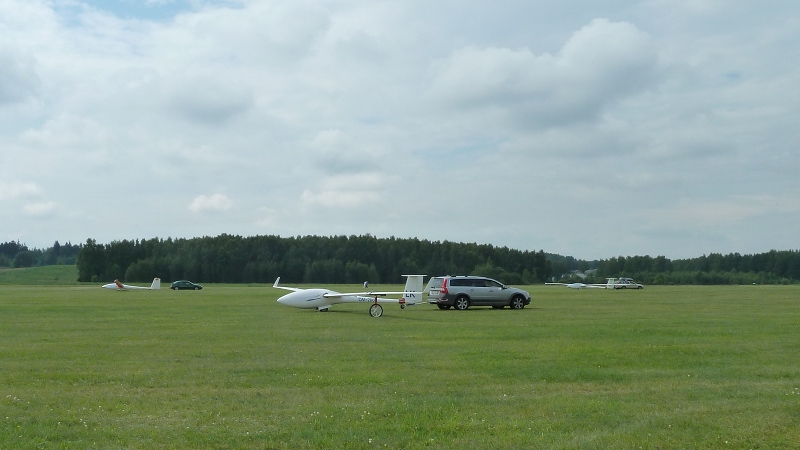 So
a task at 12, then a grid squat until 2.15 when they finally
binned the day with thunder clouds to the south and muck to
the west, cloud base around or below 2000, it wasn’t a difficult
call.
So
a task at 12, then a grid squat until 2.15 when they finally
binned the day with thunder clouds to the south and muck to
the west, cloud base around or below 2000, it wasn’t a difficult
call.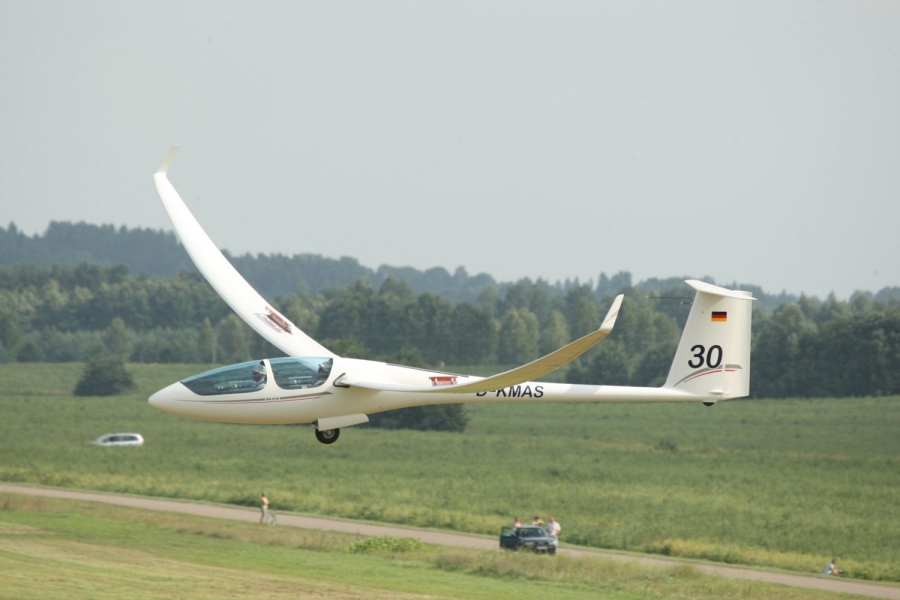 giant blue hole in the final sector. Bu this time, we were well
over time, but for the first time I thought we might actually
get back! Climbing in the rain, we nicked in and out of the
final sector, then followed a shower line part way home. I made
a little mistake and was slow getting onto glide, then too cautious
with height, but frankly, all three getting round was well enough.
giant blue hole in the final sector. Bu this time, we were well
over time, but for the first time I thought we might actually
get back! Climbing in the rain, we nicked in and out of the
final sector, then followed a shower line part way home. I made
a little mistake and was slow getting onto glide, then too cautious
with height, but frankly, all three getting round was well enough.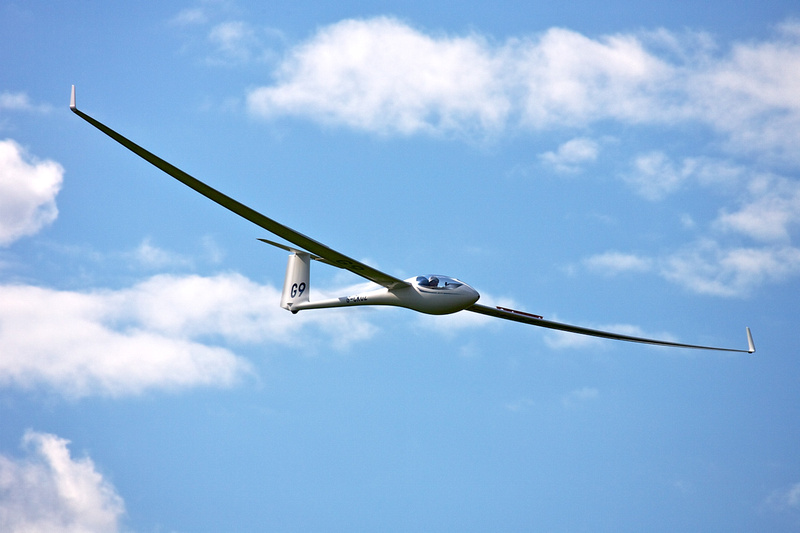 Russell and I flew together most of the flight, Russell first
a bit ahead, them me getting in front. The second leg was great,
with an excellent long street (cross wind of course) taking
us to the second turn, then we struggled a bit and separated
going south. Having got ahead, I just went slightly off the
boil and Russell caught me up in the third leg North, and we
starting to go better as a team. The final leg could have been
great but didn’t quite gel. I made a mistake from the top of
the gaggle just before the turn and the others got over the
top of me. Then Russell went straight off on track while I speared
off to the North. After committing to the route I discovered
it was way off track and not connected with the good run home
that I expected. Rather dejectedly I climbed for a safe run
home, but in the mean time, Russell and those that went straight
had a bit of bother and had to top up in 2kts while I climbed
at 4 and effectively caught up at the line.
Russell and I flew together most of the flight, Russell first
a bit ahead, them me getting in front. The second leg was great,
with an excellent long street (cross wind of course) taking
us to the second turn, then we struggled a bit and separated
going south. Having got ahead, I just went slightly off the
boil and Russell caught me up in the third leg North, and we
starting to go better as a team. The final leg could have been
great but didn’t quite gel. I made a mistake from the top of
the gaggle just before the turn and the others got over the
top of me. Then Russell went straight off on track while I speared
off to the North. After committing to the route I discovered
it was way off track and not connected with the good run home
that I expected. Rather dejectedly I climbed for a safe run
home, but in the mean time, Russell and those that went straight
had a bit of bother and had to top up in 2kts while I climbed
at 4 and effectively caught up at the line.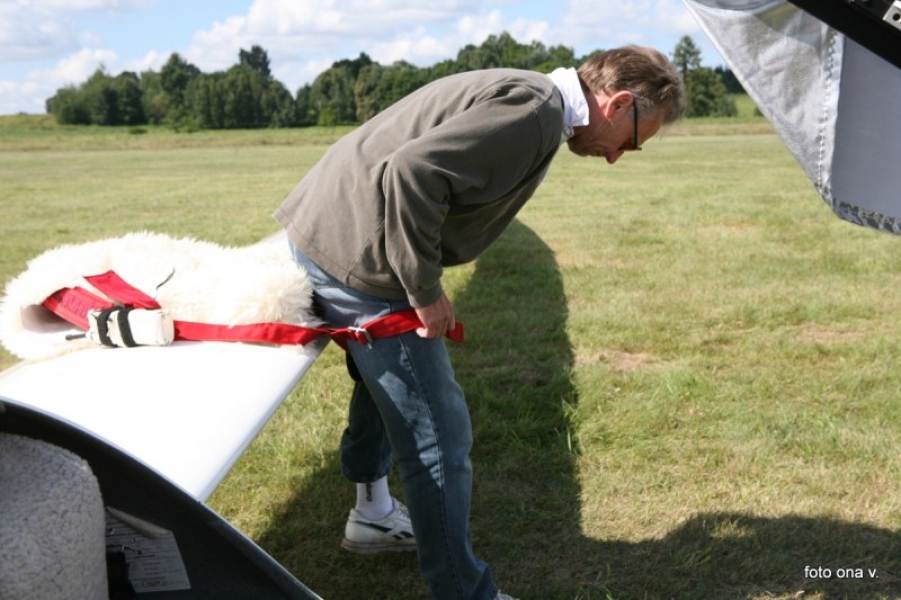 The Steve and Pete Open team was not firing on all cylinders
with another moderate day while Kim did a fantastic job starting
a little later and coming home to win.
The Steve and Pete Open team was not firing on all cylinders
with another moderate day while Kim did a fantastic job starting
a little later and coming home to win.